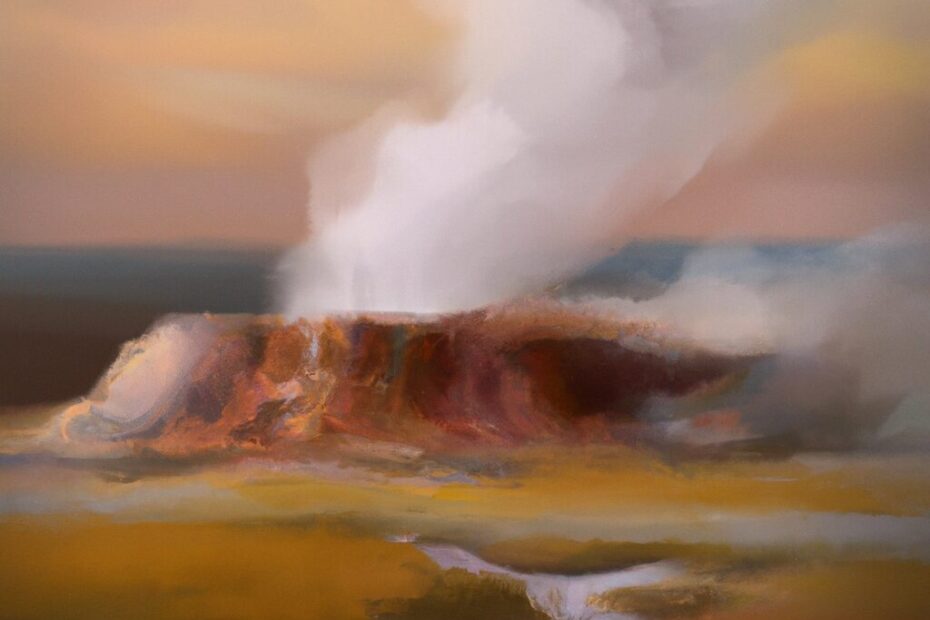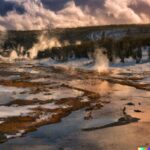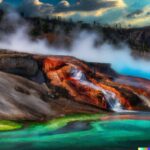Yellowstone National Park is not only known for its stunning natural beauty and diverse wildlife, but also for its mesmerizing geysers. These geothermal features hold deep cultural significance for Native American tribes, symbolizing spiritual connections to the earth and the elements.
In addition, geysers have inspired artists and writers throughout history, while also playing a significant role in the tourism industry. But how exactly do geysers form, and what causes them to erupt? Let’s explore the fascinating world of geysers, particularly the famous ones found in Yellowstone National Park.
What Are Geysers?
Geysers are natural wonders that can be found in various locations around the world, with Yellowstone National Park being one of the most famous destinations known for its impressive geothermal features.
These fascinating natural phenomena are formed when underground water is heated by magma deep within the Earth’s crust. The heat causes the water to boil and turn into steam, creating pressure that eventually erupts in powerful bursts of hot water and steam. Geysers are closely linked to volcanic activity due to their proximity to magma chambers, making them valuable indicators of the geothermal conditions beneath the Earth’s surface. The unique mix of geological factors results in the captivating thermal features that attract both tourists and researchers alike, offering insights into the Earth’s dynamic processes.
Where Is Yellowstone National Park?
Yellowstone National Park, located primarily in the U.S. states of Wyoming, Montana, and Idaho, is renowned for its breathtaking landscapes, diverse wildlife habitats, and iconic geothermal features.
Nestled within the Rocky Mountains, Yellowstone National Park spans over 2.2 million acres of pristine wilderness, making it one of the largest and oldest national parks in the United States. The park’s striking geological formations, such as the Grand Canyon of the Yellowstone and the mammoth Yellowstone Caldera, attract geology enthusiasts and nature lovers alike. With over 10,000 hydrothermal features, including the famous Old Faithful geyser and the vibrant Grand Prismatic Spring, Yellowstone showcases a volcanic landscape that constantly reminds visitors of the Earth’s dynamic forces at work.
What Is the Cultural Significance of Yellowstone Geysers?
The geysers of Yellowstone hold deep cultural significance, with ties to Native American folklore and a history of historical importance that transcends their natural beauty and geological wonder.
These geysers have been revered by Indigenous peoples for generations, with stories and legends passed down through oral traditions depicting these natural phenomena as powerful spirits of the earth. The eruption of geysers is often seen as a communication from the natural world to humanity.
Throughout history, explorers and settlers were captivated by the geysers’ magnificence, leading to increased interest in conservation and protection of these unique features. The ongoing presence of these geysers serves as a timeless reminder of the interconnectedness between nature and culture, shaping not just local heritage but also influencing wider perspectives on environmental stewardship.
What Do Geysers Symbolize in Native American Cultures?
In Native American cultures, geysers symbolize the interconnectedness of the natural world, serving as sacred sites that embody cultural traditions, environmental stewardship, and the harmonious balance between humans and nature.
These natural marvels are revered for their spiritual significance, often believed to be portals connecting the physical realm with the spiritual world. The eruptions of geysers are seen as manifestations of the Great Spirit’s power, signifying renewal and cleansing. Native American tribes have long incorporated geysers into their ceremonies, offering prayers and seeking blessings for their communities and the land. These geothermal features play a crucial role in environmental conservation efforts, promoting the preservation of natural habitats and biodiversity within tribal lands.
How Have Geysers Been Used in Art and Literature?
Geysers have long served as a wellspring of artistic inspiration and literary references, inspiring interpretive programs that delve into their geological marvels and cultural symbolism.
These natural phenomena, with their mesmerizing eruptions of water and steam, have captivated the creativity of many artists and writers throughout history. From paintings depicting the majestic power of geysers to poems that evoke their mystical essence, the influence of these thermal wonders can be seen in various forms of creative expression.
The educational value of geysers cannot be overlooked, as they provide a unique opportunity for scientific exploration and environmental awareness. Through interpretive programs, visitors can gain a deeper understanding of the geological forces at play and the cultural significance that geysers hold in different societies.
What Role Do Geysers Play in the Tourism Industry?
Geysers at Yellowstone National Park play a pivotal role in the tourism industry, offering visitors a unique and unforgettable experience that includes recreational activities and unparalleled opportunities to witness nature’s extraordinary displays.
These natural wonders captivate tourists from all around the globe, drawing them into a world of bubbling geothermal features that showcase the Earth’s raw power and beauty. Visitors can hike along boardwalks, marveling at the vibrant colors of hot springs like the Morning Glory Pool or eagerly anticipating the eruptions of iconic geysers such as Old Faithful. The thrill of waiting for a geyser to erupt, with steam billowing and the ground rumbling, creates a sense of anticipation and wonder that is truly incomparable.
How Do Geysers Form?
Geysers form through a fascinating interplay of geological processes involving underground water reservoirs heated by geothermal energy, leading to the characteristic water eruptions and steam vents that define these hydrothermal features.
This natural phenomenon involves a combination of factors, starting with rainwater seeping into the ground and circulating deep below, where it encounters heat from molten rock beneath the Earth’s surface. As the water heats up, pressure builds until eventually, the water explosively shoots upwards in a spectacular display, creating the famous spouting columns that geysers are known for. The presence of silica-rich minerals in the water also contributes to the unique formations around geyser vents and basins, adding to the geological wonders that make these features so captivating.
What Are the Different Types of Geysers?
Geysers come in various types, including hot springs, thermal pools, and hydrothermal vents, each exhibiting distinct characteristics shaped by the underlying geologic formations and geothermal basin dynamics.
- Hot springs are one of the most common types of geysers, known for their bubbling and steaming water caused by heated rocks deep beneath the Earth’s surface. These natural thermal pools are famous for their therapeutic properties and are popular destinations for relaxation and rejuvenation.
- Thermal pools, on the other hand, are often larger bodies of water that maintain a consistent temperature due to geothermal heating.
- Hydrothermal vents are unique underwater geysers that release superheated water enriched with minerals from volcanic activity, supporting diverse ecosystems deep in the ocean.”
What Causes Geysers to Erupt?
Geysers erupt due to the build-up of pressure from superheated water and steam in underground chambers, a process influenced by geothermal resources, ongoing geological studies, and the cyclic patterns of geyser activity.
These fascinating natural phenomena are predominantly found in areas with abundant geothermal activity, where heat from the Earth’s core warms underground water, creating a volatile environment. Through extensive scientific research, geologists have uncovered the intricate mechanisms responsible for geyser eruptions, shedding light on the underlying thermal processes that drive these spectacular displays. Factors such as underground water recharge rates, mineral deposits, and seismic activity also play crucial roles in the dynamics of geyser systems, offering valuable insights into the Earth’s thermal behavior and geological history.
What Is the Relationship between Geysers and Volcanoes?
The relationship between geysers and volcanoes is intertwined in the geological history of volcanic landscapes, where the dynamic interactions between these geologic features contribute to ecosystem balance and environmental resilience.
Geysers, like Old Faithful in Yellowstone National Park, are a direct result of underground volcanic activity. The superheated water trapped beneath the Earth’s surface bursts through a vent, creating spectacular water eruptions. Volcanoes play a crucial role in the formation of geysers by providing the heat source needed to generate the high-pressure steam that propels the water upwards.
This intricate relationship showcases how geologic phenomena work hand-in-hand to shape the landscapes we see today, influencing not only the physical environment but also the delicate balance of plant and animal life that inhabits these regions.
What Are the Most Famous Geysers in Yellowstone National Park?
Yellowstone National Park boasts several world-renowned geysers that stand as iconic attractions, showcasing the park’s exceptional geological formations and supporting diverse ecosystems rich in biodiversity.
- Among these famous geysers, Old Faithful is perhaps the most well-known, captivating visitors with its reliable eruptions that occur approximately every 90 minutes.
- Castle Geyser, with its distinctive cone shape and periodic massive blasts, adds an air of mystique to the landscape.
- Grand Geyser enchants onlookers with its towering eruptions reaching up to 200 feet.
- While Steamboat Geyser holds the title of the world’s tallest active geyser, often erupting unpredictably but spectacularly.
- Beehive Geyser, known for its impressive spouting and cone formation, adds to the tapestry of Yellowstone’s geothermal wonders.
Old Faithful
Old Faithful is one of Yellowstone’s most iconic geysers, renowned for its predictable eruptions and captivating displays of geothermal phenomena that continue to dazzle visitors with its geological marvels.
Visitors flock to witness the iconic eruptions of Old Faithful, where scalding waters shoot up to heights of 100-180 feet every 60-110 minutes. The geyser’s reliability in eruption intervals makes it a preferred site for geothermal research, providing scientists with valuable insights into the complex underground hydrothermal systems of Yellowstone.
The distinct cone-shaped formation surrounding Old Faithful is a testament to the geyser’s enduring presence and the powerful forces at work beneath the Earth’s surface. As a prominent geological wonder, Old Faithful stands as a reminder of the Earth’s dynamic and awe-inspiring geothermal activity.
Castle Geyser
Castle Geyser, located in Yellowstone National Park, offers a fascinating subject for environmental education and geological studies, showcasing the intricate dynamics of geyser activity and land preservation efforts.
Visitors to Castle Geyser can witness firsthand the stunning displays of water and steam erupting from the earth, providing a unique opportunity to learn about geothermal energy and the delicate balance of nature.
Scientists are drawn to Castle Geyser for its role in ongoing research on geothermal features and their significance in understanding Earth’s geological processes.
Conservation initiatives in the park emphasize the importance of preserving geyser habitats to protect biodiversity and maintain the natural wonders for future generations.
Grand Geyser
Grand Geyser, a majestic feature of Yellowstone, underscores the critical importance of habitat protection and adherence to environmental policies that safeguard the delicate ecosystems surrounding these geologic wonders.
Its powerful eruptions are not merely awe-inspiring displays of nature’s raw energy but also serve as a stark reminder of the need for sustainable park management practices. Through stringent conservation measures and the implementation of eco-friendly policies, the National Park Service works tirelessly to ensure that iconic geysers like Grand Geyser continue to flourish in their natural state, free from human disturbances.
By prioritizing the preservation of these unique habitats, we can play a significant role in safeguarding the ecological richness and unparalleled beauty of these thermal features for future generations.
Steamboat Geyser
Steamboat Geyser, known for its record-breaking eruptions, offers insights into the geologic history of Yellowstone and underscores the park’s adaptation strategies in the face of changing climates and environmental challenges.
Geologists study the unique geological formations surrounding Steamboat Geyser to unravel the complex processes that trigger its spectacular displays. By examining the mineral composition of the geyser’s deposits and studying seismic activity in the region, researchers gain valuable data on the underlying tectonic forces that influence geyser behavior. Understanding these dynamics is crucial for predicting future eruptions and managing risks within the park.
The ecological significance of this natural wonder extends beyond its geological marvels, as the geothermal features provide unique habitats for thermophilic microorganisms and contribute to the park’s overall biodiversity.
Beehive Geyser
Beehive Geyser, with its distinctive cone-shaped eruptions, showcases the essential role geysers play in maintaining ecosystem balance and providing vital ecosystem services that support the biodiversity of Yellowstone National Park.
The eruptions of Beehive Geyser not only mesmerize visitors but also contribute significantly to thermal regulation within the park ecosystem. By releasing hot water and steam, the geyser helps regulate temperatures and create unique microhabitats that support a variety of plant and animal species. These habitats are crucial for promoting species diversity and ensuring the overall health of the park’s ecosystem. Therefore, preserving geyser habitats like Beehive Geyser is imperative for sustaining the rich biodiversity of Yellowstone National Park.
Last Updated on February 7, 2024 by Jon Waraas – Originally Posted: February 7, 2024

I’m Jon Waraas, and I’ve been navigating the online world since 2006. By day, I’m the proud owner of some eCommerce gems, and by night, I’m the voice behind the adventures on Waraas.Com.
My heart, however, belongs to the wild beauty of Yellowstone National Park. I’ve got a collection of websites dedicated to sharing the wonders of this natural masterpiece. Oh, and did I mention? I’m currently building my own cabin inside the ghost town of Gilmore, Idaho – a cabin with tales to tell!
When I’m not immersed in the digital realm, you’ll find me lacing up my boots for a good hike or setting up camp under the star-studded sky.




